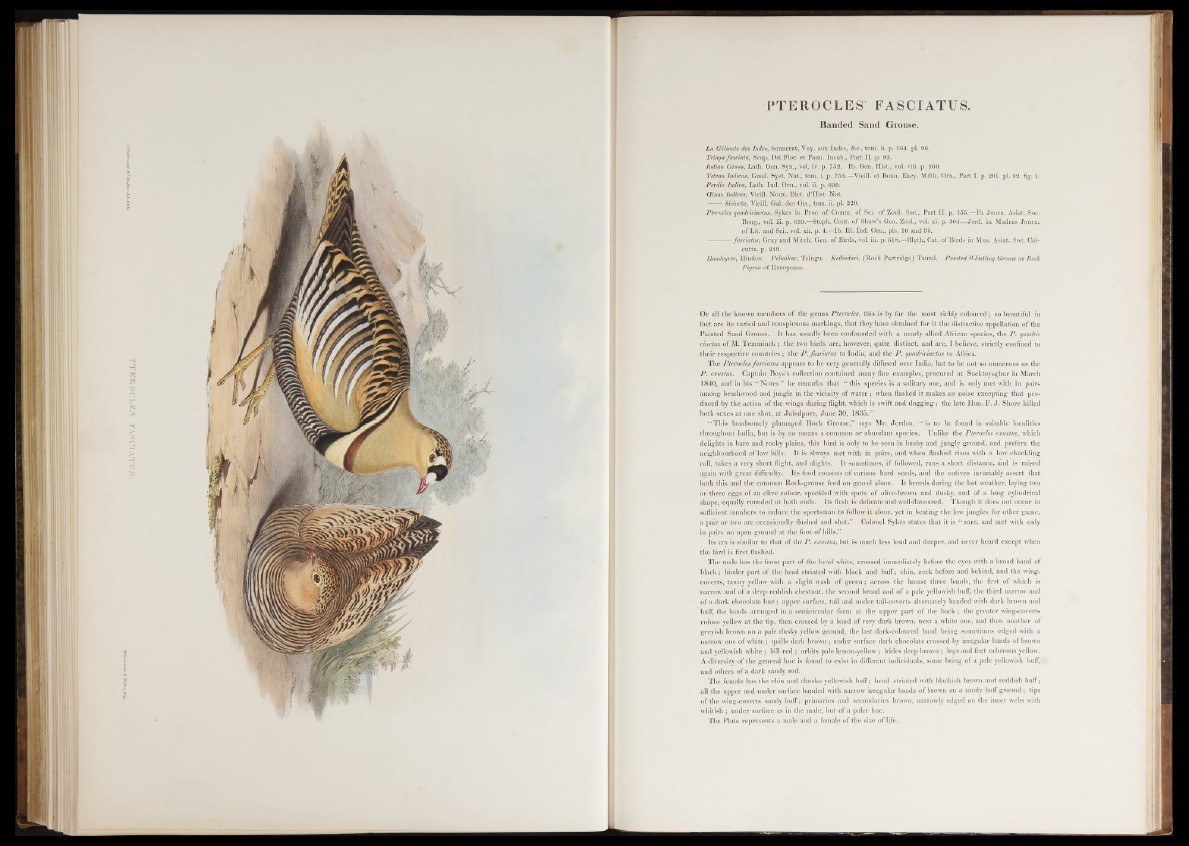
PTEROCLES FASCIATUS.
Banded Sand Grouse.
La GMinote des Indes, Sonnerat, Voy. aux Indes, &c., tom. ii. p. 164. pl. 96.
Tringa fasciata, Seop. Del Flor, et Faun. Insub., Part II. p. 92.
Indian Grous, Lath. Gen. Syn., vol. iv. p. 752. Ib. Gen. Hist.,-vol. viii. p. 260.
Tetrao Indiens, Gmel. Syst. Nat., tom. i. p. 755.—Yieill. et Bonn. Ency. Meth. Om., Part I. p. 201. pl. 92. fig. 1.
Perdix Indica, Lath. Ind. Om., vol. ii. p. 650.
CEnas Indicus, Yieill. Nouv. Diet. d’Hist. Nat.
bicincta, Yieill. Gal. des Ois., tom. ii. pl. 220.
Pterocles quadricinctusi Sykes in Proc. o f Comm, of Sei. o f Zool. Soc., Part II. p. 155.— Ib. Joum. Asiat. Soc.
Beng., vol. iii. p. 639.—Steph. Cont. o f Shaw’s Gen. Zoöl., vol. xi. p. 304.—Jerd. in Madras Joum.
of Lit. and Sei., vol. xii. p. 4.—Jb. 111. Ind. Om., pls. 10 and 36.
— fasciatus, Gray and Mitch. Gen. o f Birds, vol. iii. p. 518.—Blyth, Cat. o f Birds in Mus. Asiat. Soc. Calcutta,
p. 249.
Hundeyree, Hindoo. Polunkar, Telugu. Kelkudari, (Rock Partridge) Tamul. Painted Whistling Grouse or Rock
Pigeon of Europeans.
O f all the known members o f the genus Pterocles, this is by far the most richly coloured; so beautiful in
fact are its varied and conspicuous markings, that they have obtained for it the distinctive appellation o f the
Painted Sand Grouse. It has usually been confounded with a nearly allied African species, the P . quadri-
cinctus of M. Temminck; the two birds are, however, quite distinct, and are, I believe, strictly confined to
their respective countries ; the P . fasciatus to India, and the P . quadricinctus to Africa.
The Pterocles fasciatus appears to be very generally diffused over India, but to be not so numerous as the
P . exustus. Captain Boys’s collection contained many fine examples, procured at Suckteysghur in March
1840, and in his “ Notes” he remarks that “ this species is a solitary one, and is only met with in pairs
among brushwood and jungle in the vicinity of water; when flushed it makes no noise excepting that produced
by the action of the wings during flight, which is swift and dogging; the late Hon. F. J . Shore killed
both sexes at one shot, at Jubulpore, June 30, 1835.”
“ This handsomely plumaged Rock Grouse,” says Mr. Jerdon, “ is to be found in suitable localities
throughout India, but is by no means a common or abundant species. Unlike the Pterocles exustus, which
delights in bare and rocky plains, this bird is only to be seen in bushy and jungly ground, and prefers the
neighbourhood of low hills. It is always met with in pairs, and when flushed rises with a low chuckling
call, takes a very short flight, and alights. It sometimes, if followed, runs a short distance, and is raised
again with great difficulty. Its food consists of various hard seeds, and the natives invariably assert that
both this and the common Rock-grouse feed on gravel alone. It breeds during the hot weather, laying two
or three eggs of an olive colour, speckled with spots of olive-brown and dusky, and of a long cylindrical
shape, equally rounded at both ends. Its flesh is delicate and well-flavoured. Though it does not occur in
sufficient numbers to induce the sportsman to follow it alone, yet in beating the low jungles for other game,
a pair or two are occasionally flushed and shot.” Colonel Sykes states that it is “ rare, and met with only
in pairs on open ground at the foot of hills.”
Its cry is similar to that of the P . exustus, but is much less loud and deeper, and never heard except when
the bird is first flushed.
The male has the front part of the head white, crossed immediately before the eyes with a broad band of
black; hinder part of the head striated with black and buff; chin, neck before and behind, and the wing-
coverts, tawny yellow with a slight wash o f green ; across the breast three bands, the first of which is
narrow and of a deep reddish chestnut, the second broad and of a pale yellowish buff, the third narrow and
of a dark chocolate hue; upper surface, tail and under tail-coverts alternately banded with dark brown and
buff, the bands arranged in a semicircular form at the upper part of the back; the greater wing-coverts
rufous yellow at the tip, then crossed by a band o f very dark brown, next a white one, and then another of
greyish brown on a pale dusky yellow ground, the last dark-coloured band being sometimes edged with a
narrow one of white; quills dark brown; under surface dark chocolate crossed by irregular bands of brown
and yellowish white; bill red ; orbits pale lemon-yellow; irides deep brown ; legs and feet ochreous yellow.
A diversity of the general hue is found to exist in different individuals, some being of a pale yellowish buff,
and others of a dark sandy red.
The female has the chin and cheeks yellowish buff; head striated with blackish brown and reddish buff;
all the upper and under surface banded with narrow irregular bands of brown on a sandy buff ground; tips
of the wing-coverts sandy buff; primaries and secondaries brown, narrowly edged on the inner webs with
whitish ; under surface as in the male, but o f a paler hue.
The Plate represents a male and a female of the size of life.